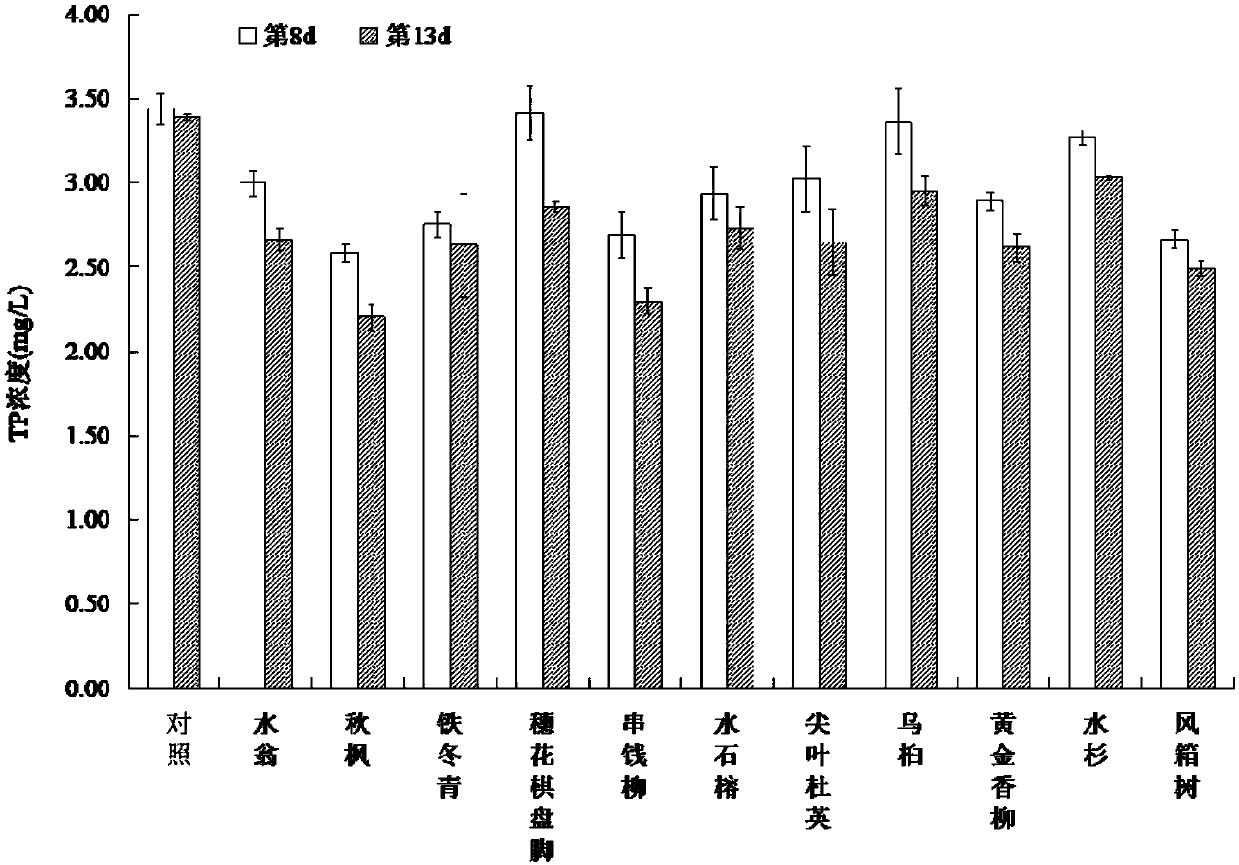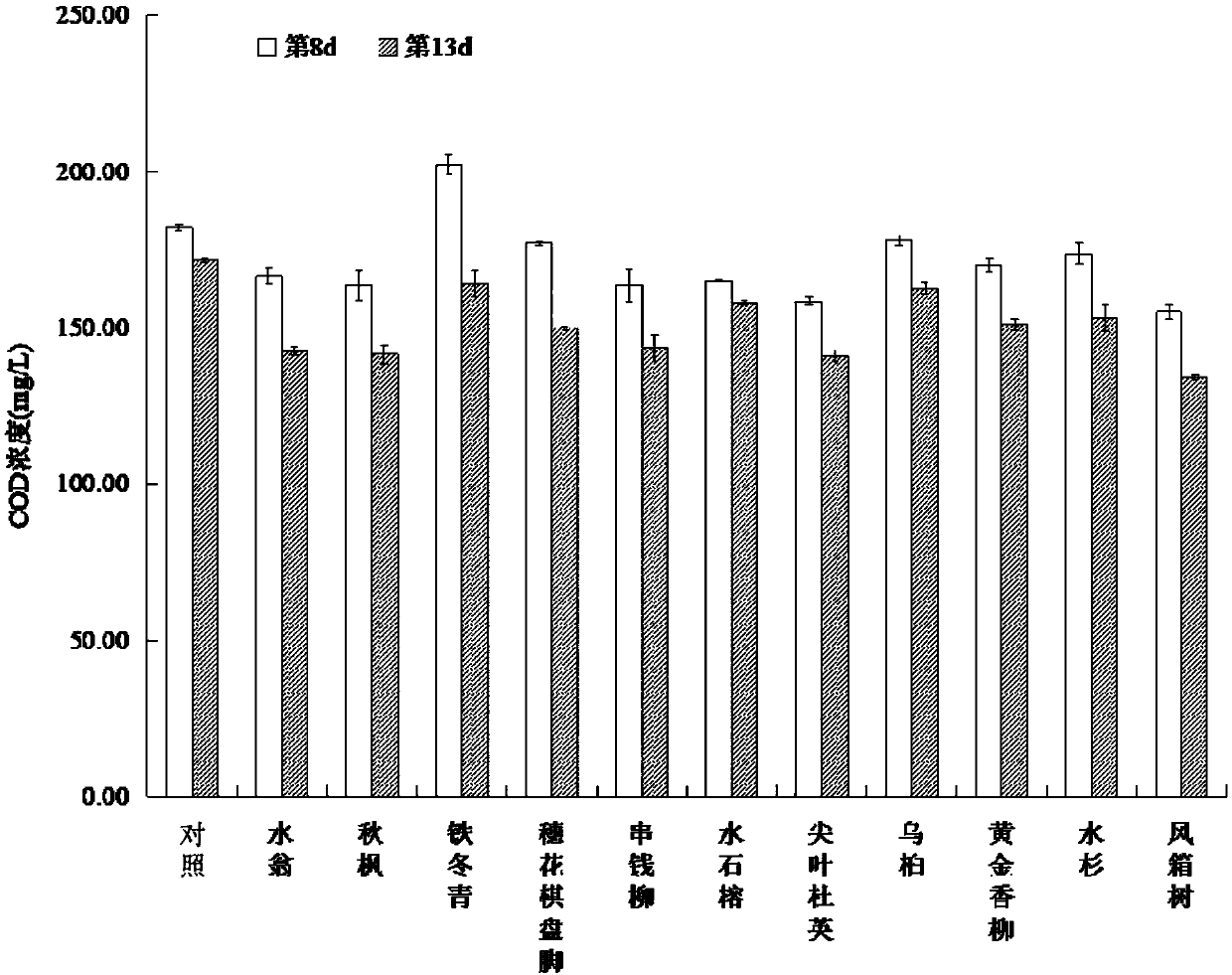A method for purifying water body using wetland woody plants
A technology of woody plants and water purification, applied in the field of water purification, to achieve rich diversity, good effect, and good decontamination effect
- Summary
- Abstract
- Description
- Claims
- Application Information
AI Technical Summary
Problems solved by technology
Method used
Image
Examples
experiment example 1
[0058] Growth status of experimental example 1 plant
[0059] The growth state of plants can indirectly or directly reflect the pollution resistance and purification ability of plants. In the early stage of the experiment, various woody plants grew well, among which the autumn maple, carnation and ficus were more obvious, and the new leaves and roots of the plants were also relatively good. good. In the later stage of the test, due to the different water and pollution resistance of the 11 species of woody plants, some woody plants grew slowly, and some of the leaves of Chiselia fringa and Chinese tallow tree withered and yellowed, while some of the plants of Golden Fragrant Willow and Metasequoia withered and died in the later stage of the test The phenomenon of water weng, iron holly, pointed-leaved duying and bellows did not change much from the shape of the plants before the test.
[0060] The chlorophyll content, malondialdehyde, and plant root activity of 11 kinds of woo...
experiment example 2
[0063] Purification effect of experimental example 2 on total nitrogen in water
[0064] figure 1 The purification effect of 11 species of woody plants on total nitrogen (TN) in water is determined by figure 1 It can be seen that the change of TN concentration in the control group was relatively stable during the experiment, and at the end of the experiment, the TN concentrations of the 11 woody plant treatment groups were all lower than those in the control group. On the 8th day, the TN concentrations of each treatment group decreased, among which, the TN concentrations of the treatments of Carica carmona and Qiufeng decreased the most significantly, decreasing by 2.27mg / L and 2.05mg / L respectively, while Metasequoia had the best TN removal effect. Poor, only decreased by 0.24mg / L, except Metasequoia and bellows tree, which had no significant difference from the control, the rest of the plants had significant differences from the control. From the 8th day to the 13th day, t...
experiment example 3
[0066] Purification effect of experimental example 3 on total phosphorus in water
[0067] figure 2 is the purification effect of 11 species of woody plants on total phosphorus (TP) in the water body, determined by figure 2 It can be seen that during the test, the TP concentration in each treatment showed a downward trend. On the 8th day, compared with the control, there was no significant difference in the TP concentration in the depleted water of Suicha, Chinese tallow and Metasequoia, and the TP concentration in the rest of the treatments decreased significantly, and the difference was significant, while the autumn maple, bellows tree and Carina carunculus had no significant difference The removal effect of TP concentration in water was better; on the 13th day, compared with the control, the removal effects of the other treatments on TP in water were more obvious than that of the control, and these 3 plants were compared with There was no significant difference in the c...
PUM
 Login to View More
Login to View More Abstract
Description
Claims
Application Information
 Login to View More
Login to View More - R&D
- Intellectual Property
- Life Sciences
- Materials
- Tech Scout
- Unparalleled Data Quality
- Higher Quality Content
- 60% Fewer Hallucinations
Browse by: Latest US Patents, China's latest patents, Technical Efficacy Thesaurus, Application Domain, Technology Topic, Popular Technical Reports.
© 2025 PatSnap. All rights reserved.Legal|Privacy policy|Modern Slavery Act Transparency Statement|Sitemap|About US| Contact US: help@patsnap.com



